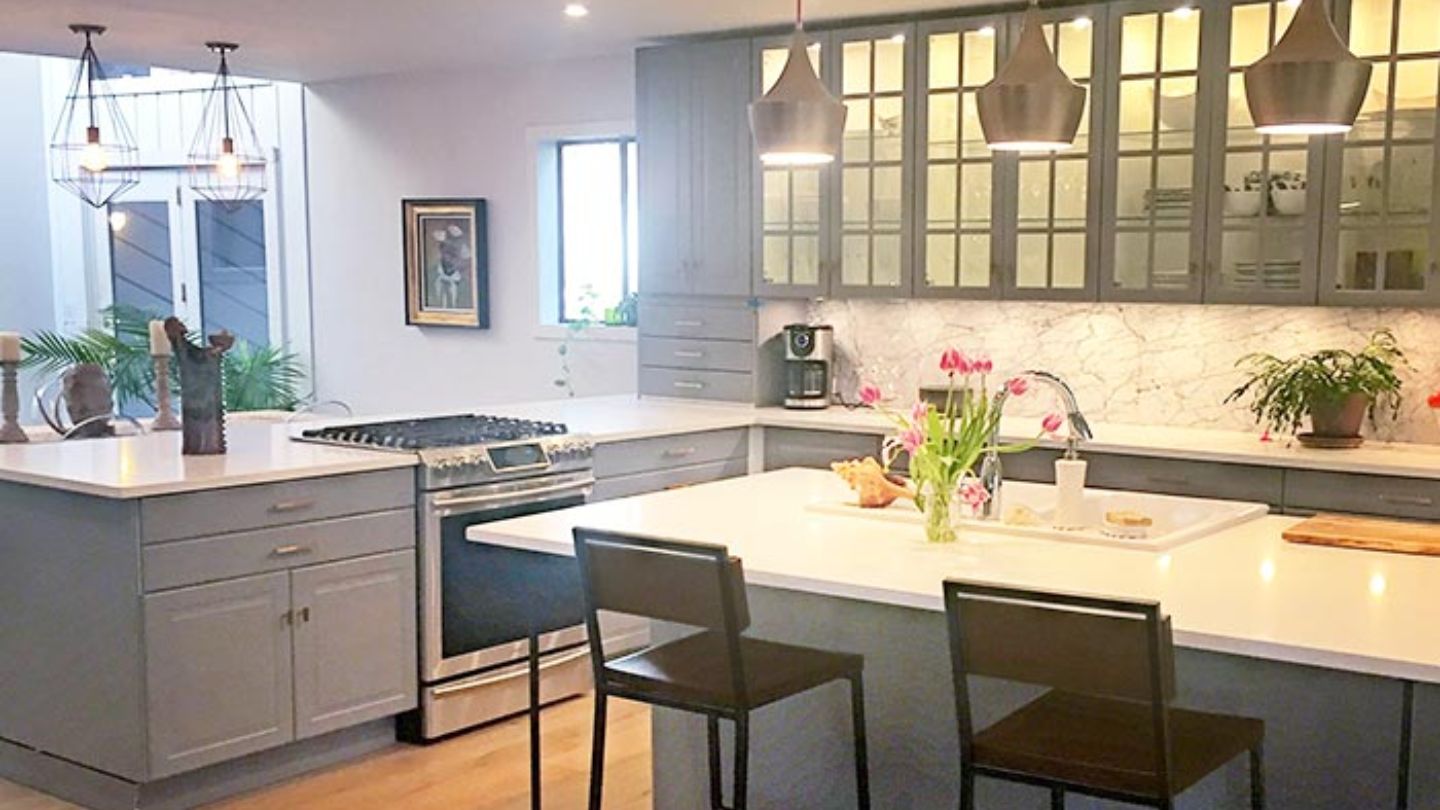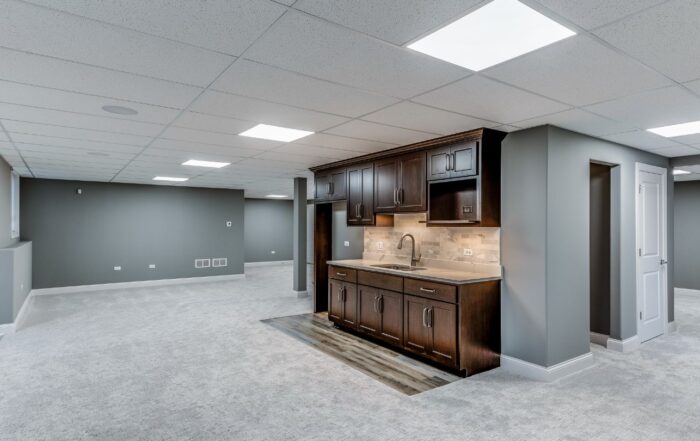Renovation vs Remodeling: What’s the Difference?
Home
Blog
- Renovation vs Remodeling: What’s the Difference?
Thinking of renovating or remodeling your home? Here’s the lowdown on the differences between renovation and remodeling to help you decide. A renovation refers to restoring something to its former state, while a remodel involves creating something new. Understanding these differences is crucial for homeowners planning home improvement projects.
Key Takeaways
- Renovation is cosmetic and refreshes a space. Remodeling is structural and enhances functionality.
- Renovation projects are cheaper and less complicated than remodeling, so you can do DIY.
- Choose the right contractor for both renovation and remodeling to ensure project execution.
What is Renovation and Remodeling
Renovation projects make old look new again, focusing on cosmetic improvements. This means making something look and feel new. This can include painting walls, laying new flooring, and replacing fixtures – basically, a beauty treatment for your living space.
Remodeling goes beyond surface-level changes to alter the functionality and layout of a space. For example, tearing down walls to create an open floor plan or totally changing how a kitchen is laid out is remodeling. These types of home improvement projects are more than just renovations and usually require professional help because of their complexity.
Now that you know what renovation and remodeling mean, you can decide which one is for you – whether that’s renovating with cosmetic changes for freshness or remodeling to redefine your space’s purpose. Understanding the specific nature of your home project is crucial for effective planning and budgeting.
Renovation vs Remodeling
Renovation projects are distinguished from remodeling projects by scale, cost, and complexity. A renovation is meant to improve the look and feel of the home through surface-level changes without major structural changes. Examples of renovations are painting walls, updating floors, or installing new light fixtures. These can be done quickly and easily with professional help.
Home renovations are generally more budget-friendly for homeowners since they involve surface-level changes that don’t require extensive labor or structural alterations. Remodeling projects, on the other hand, are typically more expensive due to the significant structural modifications.
The difference between renovations and remodeling also extends to manageability and expertise: Renovations are simple updates that don’t need specialized knowledge. Remodeling projects can be complex tasks like reworking electrical systems, addressing plumbing needs, or modifying load-bearing walls – all require skilled professionals.
Planning and Execution
Planning a Home Renovation Project
Planning a home renovation project is crucial to ensure a successful outcome. Start by setting clear goals and determining a realistic budget. Consider what you want to achieve with your renovation – whether it’s updating the look of your home, improving functionality, or increasing property value. Assess your needs and wants and prioritize them based on your budget and timeline.
A well-planned home renovation project should include a detailed scope of work, a timeline, and a budget. Working with a professional contractor can help you create a comprehensive plan that outlines the project’s objectives, timelines, and costs. Don’t forget to include a contingency fund to cover unexpected expenses that may arise during the renovation process.
Professional Expertise
While some home renovation projects might seem suitable for DIY, it is safer to let professionals do it. There are significant benefits to hiring a professional team. Professional expertise ensures that the project is completed to the highest standards, with attention to detail. Simple renovations such as painting, installing new flooring, or replacing light fixtures can be done by homeowners, but it is not safe, and the quality and efficiency of a professional touch can provide the best results.
Complex projects, such as electrical or plumbing work or structural changes, absolutely require the expertise of a licensed professional. Attempting these tasks without the necessary skills can lead to costly mistakes and safety hazards. Professionals bring years of experience and specialized knowledge to handle these intricate tasks safely and effectively.
Consider the time and effort required to complete a DIY project. Professional contractors can save you significant time and effort, allowing you to focus on your daily responsibilities. They manage the project from start to finish, ensuring timely completion and high-quality results.
Cost and Value
Cost Comparison
The cost of a home renovation project can vary widely depending on the scope of the project, the materials used, and the location of the property. Research and compare prices for materials and labor to ensure you are getting the best value for your money. Renovation projects can be more cost-effective than remodeling projects, as they often involve updating existing features rather than replacing them entirely. However, the cost of a renovation project can still be significant, so it’s important to budget accordingly.
Consider the value that a renovation project can add to your property. A well-planned and executed renovation project can increase the value of your home, making it more attractive to potential buyers if you decide to sell in the future. For example, updating a kitchen with new countertops and cabinet doors can provide a fresh look without the need for major construction work.
In contrast, remodeling projects can be more expensive, as they often involve making significant changes to the structure or layout of a property. However, remodeling projects can also add significant value to a property, especially if they involve updating outdated features or improving the functionality of the space. For instance, creating an open floor plan by removing walls can make a home feel more spacious and modern.
Ultimately, the cost and value of a home renovation project depend on the specific goals and objectives of the project. Work with a professional contractor to determine the best course of action for your project and to ensure that you are getting the best value for your money.
When to Undertake a Home Renovation
Renovation is a good option for those with a limited budget. Renovation projects are quick and cost-effective and can be done by the homeowners themselves. Projects like painting walls, replacing old light fixtures, or laying new flooring are simple renovations that can make a big impact without breaking the bank. Careful planning and budgeting are essential for any home project to ensure cost-effectiveness and avoid unnecessary expenses.
Renovations are a great way to get aesthetic improvements without changing the layout of the home. These home improvement projects can refresh spaces without altering the structure. For example, replacing cabinet doors, updating countertops, and a fresh coat of paint can transform a kitchen without the need for major construction work.
When to Remodel
Renovation is necessary when you want to tailor the layout of your home to your lifestyle. This means tearing down walls to create an open floor plan or adding a room for more living space. The benefit of this process is the functionality it provides so homes can better accommodate their occupants.
Another reason to remodel is to increase energy efficiency. By updating windows, doors, and insulation materials, you can save on energy bills and increase comfort in the home. Renovation can fix outdated architectural designs of older homes by modernizing them.
There are downsides like high cost and long time frame that can strain your budget and other plans. Although these are challenges, they are often offset by the benefits of space optimization, which makes renovation a good investment.
Examples of Renovation Projects
Homeowners can do cost-effective renovation projects like painting walls, replacing light fixtures, and installing energy-efficient lighting. These improvements not only make your space look better but also reduce power consumption – with modern fixtures saving a lot.
Flooring a room is another popular renovation task that can greatly impact a home’s feel. Choosing hardwood floors, laminate, or new carpeting are options that can totally change the look and feel of your space. More extensive renovations might include new shingles, new windows, or a new garage door.
These types of projects are meant to refresh the existing features of a home, not the structure itself.
Examples of Remodeling Projects
Remodeling projects can change both the structure and functionality of your home. This can include reconfiguring a kitchen for better use, adding an expansion to increase living space, or enlarging a bathroom for more luxury.
Making your home more functional and beautiful is the core of these projects. For example, tearing down walls to create an open-concept area can make your home feel bigger and more navigable. Building additional rooms or expanding existing areas provides more square footage.
These renovations address not only the aesthetics but also the underlying design flaws of your home. These investments pay off big time in your living space.
Choosing the Right Contractor
The success of your renovation or remodeling project depends on choosing the right professional contractor. Licensed and insured contractors may have a better understanding of the building codes in your area and be more available to communicate. Check a contractor’s past projects and verify their experiences to gauge their competence and reliability.
Have a written agreement in place before work starts detailing the scope of the project and payment terms. This agreement should state what will be done, timelines, and itemized costs so there’s no confusion later on, and the project can run smoothly.
Choosing seasoned professional contractors can be a big help when doing complex remodeling projects by saving time, money, and stress. Their expertise and experience will greatly impact the outcome of any project.
Conclusion
Knowing the difference between renovation and remodeling is key to any homeowner looking to upgrade their space. Home renovations in Milton are more budget-friendly and cosmetic, while remodeling projects require structural changes and more investment. Knowing when to choose each will save you time, money, and effort.
Choosing the right contractor is also an important step to ensure the success of your home improvement project. Whether you’re doing a minor renovation or a major remodel, having a plan and the right team, such as Bradford Crafted, will make all the difference.
FAQs
Which projects are typically considered renovations?
Projects like painting walls, updating flooring, replacing fixtures, and installing energy-efficient lighting are typically considered renovations as they focus on cosmetic improvements without altering the structure.
Are renovations more cost-effective than remodeling?
Generally, renovations are more cost-effective than remodeling because they involve surface-level changes and don’t require extensive labor or structural alterations.
Do renovation projects require permits?
Most simple renovation projects do not require permits. However, major renovations, especially those involving structural changes, plumbing, or electrical work, will require permits. Always check with your local authorities.
How can I decide whether to renovate or remodel?
Decide based on your goals, budget, and the extent of changes needed. Renovate for cosmetic updates and remodeling for structural changes to improve functionality. Consulting with a professional can also help you make an informed decision.
Table of Contents
Recent Blogs
Top Qualities to Look For in A Composite Deck Contractor
Searching for a composite deck contractor? Knowing the essential qualities to prioritize when selecting a company is crucial to ensure [...]
4 Great Reasons You Should Renovate Your Basement Today
Thinking about renovating your basement? Here are four great reasons you should renovate your basement now. Turning an underutilized space [...]
Top Things to Consider When Building a Porch in Milton
Planning to build a porch in Milton? There are several important things to consider when building a porch in Milton, [...]








